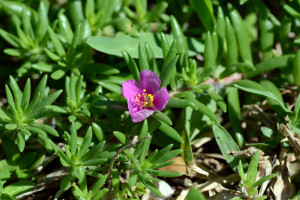I didn’t plant this pretty little weed, known variously as pink purslane, kiss-me-quick, or pigweed, but I’m glad to see it volunteering in my yard. Pink Purslane, known to horticulturists as Portulaca pilosa, is a low-growing plant with succulent leaves (succulent in both the technical and culinary senses) and pretty little pink flowers (although if you plan to eat it, I understand it’s better to do so before the plant puts out its flowers).

Etymology: According to my Brown (1927), the common name, purslane, comes to us from the Old French porcelaine, which is from the Latin porcilaca, a corruption of portulaca. Lewis and Short’s Latin Dictionary (1879) and the OED both give the spelling purslain, while the latter goes on to explain that portulaca was taken as a generic name by Tournefort in 1700. Apparently it translates literally as “little gate” (porte, right?), describing the lid on the fruit capsule. Pilosa means pilose, hairy.
I don’t know much about culinary or nonculinary edibles, but there’s a good account of this plant over at My Herbal Notebook that you might want to read sometime. For some reason, Dan Austin didn’t include this widespread native plant in his Florida Ethnobotany; perhaps there aren’t any records or traditions of its use here or in the wider Caribbean.
